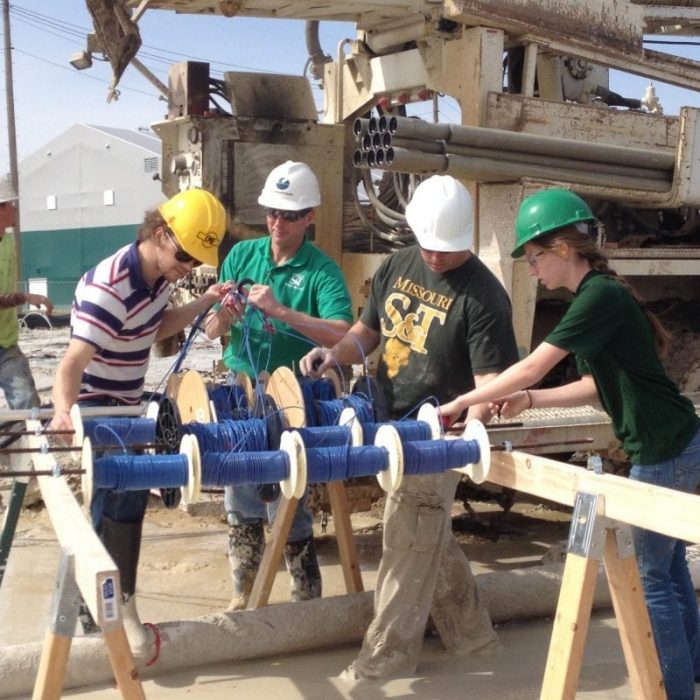
The Earth’s subsurface remains at a relatively stable temperature at a given depth despite daily and seasonal changes in the weather at the surface. Rock and soil also have the ability to store heat energy for long periods of time.
Ground-coupled heat pump (GCHP) systems can store or extract heat energy from the subsurface using heated or cooled water that is pumped through a series of boreholes, which is referred to as a borehole heat exchanger (BHE) or ground-coupled heat exchanger. Energy from buildings can be stored in the subsurface in the summertime for cooling. The energy can also be transferred from the subsurface to the building in the winter for heating. Heat pumps are efficient as they simply transfer energy from one place to another. In the case of GCHP systems, heat is transferred between the ground and buildings via a circulating fluid for heating and cooling.
Large-scale GCHP systems are becoming more and more common as institutions such as colleges, government agencies, and corporations find ways to reduce their carbon footprint and heat and cool workspaces more efficiently. Recent systems at the Missouri University of Science and Technology, Ball State University, Robert Stockton College, and the Colorado and Michigan State Capitols have recently completed these large-scale GCHP systems. The Missouri University of Science and Technology system replaced an aging coal-fired power plant and has since reported a 57 percent decrease in energy consumption, a reduction of carbon dioxide emissions by 25,000 tons, and a decrease in water consumption by 18.7 million gallons per year.

Installing the thermocouples for the study (Credit: Dr. Yovanna Cortes Di Lena)
Despite the surge in construction of these large systems, very little attention is given to the groundwater conditions before construction. The design of the system hinges on a single thermal response test (TRT) which is generally conducted over a 48-hour period. The TRT determines the overall thermal properties of the rock and soil in the subsurface. This dictates the size of a BHE such as depth and number of boreholes.
In two recent papers, “The effect of seasonal groundwater saturation on the effectiveness of large scale borehole heat exchangers in a karstic aquifer,” and “The observed effects of changes in groundwater flow on a borehole heat exchanger of a large scale ground coupled heat pump system,” both recently published in Geothermics, David Smith, A.C. Elmore, and Jordan Thompson show that changes the aquifer over long periods of time such as saturation and groundwater flow can greatly affect the performance of these large-scale GCHP systems.
The study focused on the performance of a large 144 well BHE located at the Missouri University of Science and Technology over a period of several years. The BHE was constructed in a very productive karstic dolomite and sandstone aquifer that generally would experience changes in water levels between 30-40 feet and also modest changes in flow due to the operation of large municipal wells around the site.
The research showed that during dry periods when water levels in the aquifer decreased and saturation decreased, the effectiveness of the BHE would also decrease by as much as 50 percent. The BHE tended to have the highest efficiency in the late spring when water levels were highest due to recent rains. Groundwater flow was also shown to affect the performance of the BHE, however, changes in flow were small and the effects on the BHE were also smaller compared to the effects of changes in groundwater levels.
The papers present strong evidence that the industry standard single thermal response test alone may not be enough for the proper design of these large expensive systems. A single thermal response test could lead to oversizing or under sizing of a system depending on when it is conducted. Proper characterization of subsurface such as lithology, long-term groundwater levels, and groundwater flow coupled with multiple thermal response tests will give designers of these systems a range of subsurface conditions for which the system can be designed for.
These findings are described in the articles entitled, The effect of seasonal groundwater saturation on the effectiveness of large scale borehole heat exchangers in a karstic aquifer, and The observed effects of changes in groundwater flow on a borehole heat exchanger of a large scale ground coupled heat pump system, both recently published in journal Geothermics. This work was conducted by David Smith, A.C. Elmore, and Jordan Thompson from the Missouri University of Science and Technology.
References:
- Smith, D.C., Elmore, A.C. and Thompson, J., 2018. The effect of seasonal groundwater saturation on the effectiveness of large scale borehole heat exchangers in a karstic aquifer. Geothermics, 75, pp.164-170.
- Smith, D.C. and Elmore, A.C., 2018. The observed effects of changes in groundwater flow on a borehole heat exchanger of a large scale ground coupled heat pump system. Geothermics, 74, pp.240-246.









